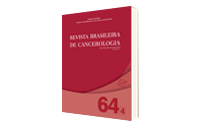Bladder Plexiform Neurofibroma in Neurofibromatosis Carrier: a Case Report
DOI:
https://doi.org/10.32635/2176-9745.RBC.2018v64n4.209Keywords:
Neurofibromatosis 1, Neurofibroma, Plexiform, Urologic NeoplasmsAbstract
Introduction: Type 1 neurofibromatosis is an inherited autosomal dominant disease with complete penetrance and is related to mutations in the NF1 gene (17q11.2). It presents extremely variable expression and predisposition to the occurrence of tumors. Complications such as visceral neurofibromas occurs in only 1% of NF1 cases. Vesical neurofibromas are extremely rare. Case report: Here in, we expose a case of a 4 years old boy, who presented signs and symptoms of urinary and intestinal dysfunction associated with lumbosacral spine deviation. His physical exam had neurofibromatosis type 1 features and the complementary exams revealed a vesical neurofibroma. Subsequently, a neurofibromatosis type 1 diagnosis was performed. Conclusion: Diagnose tumor predisposing syndromes and associated complications is essential for these patients.









